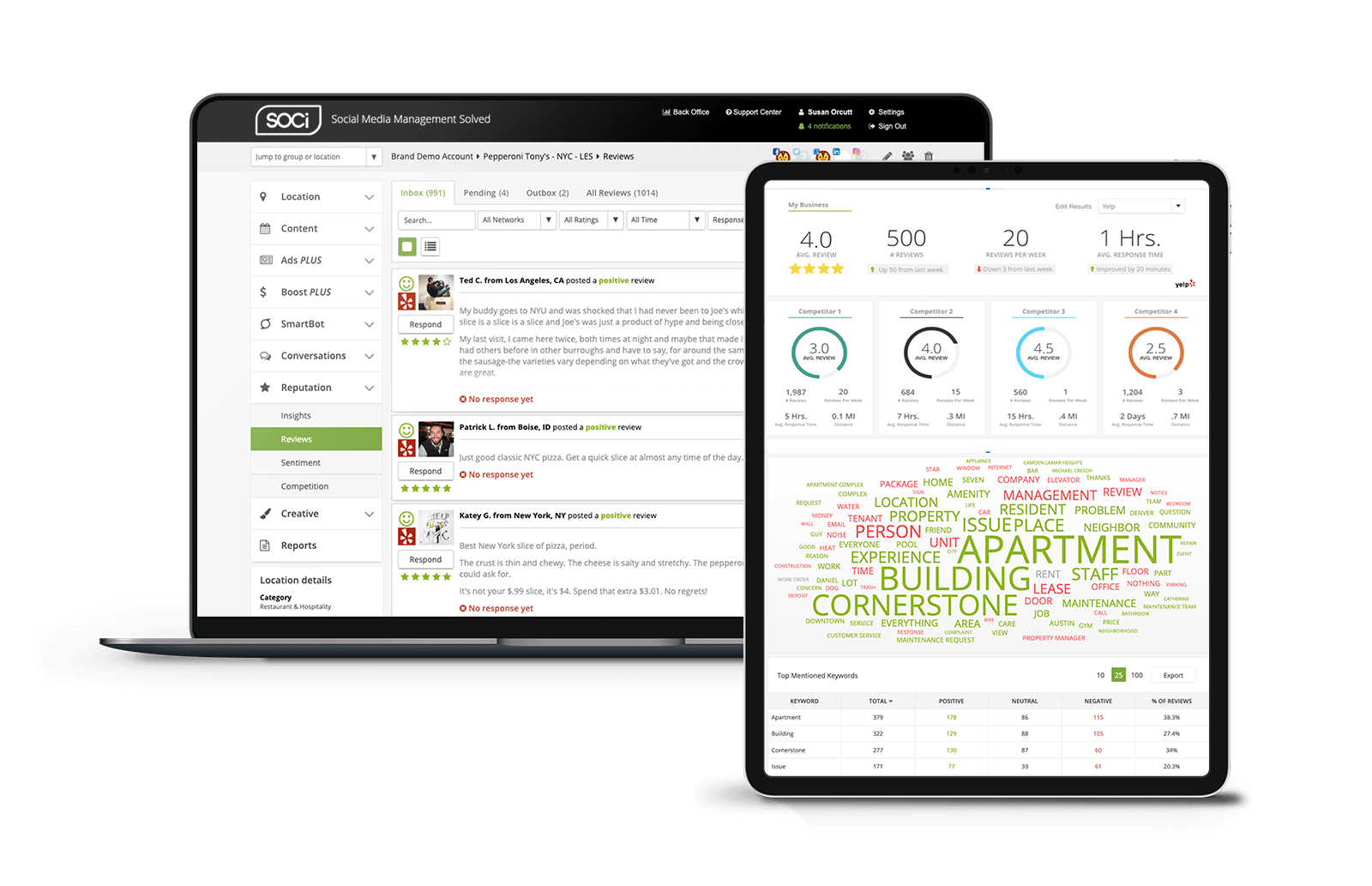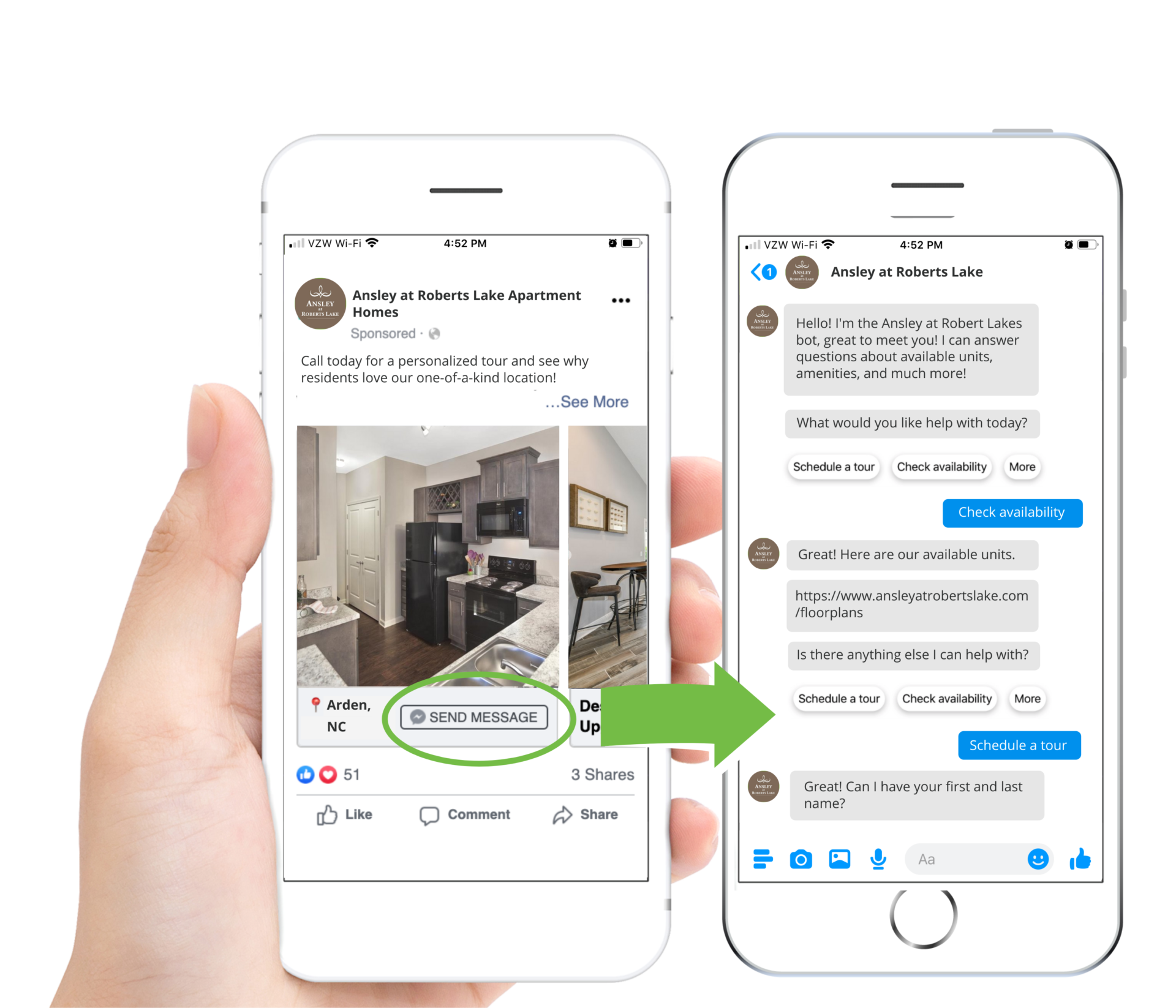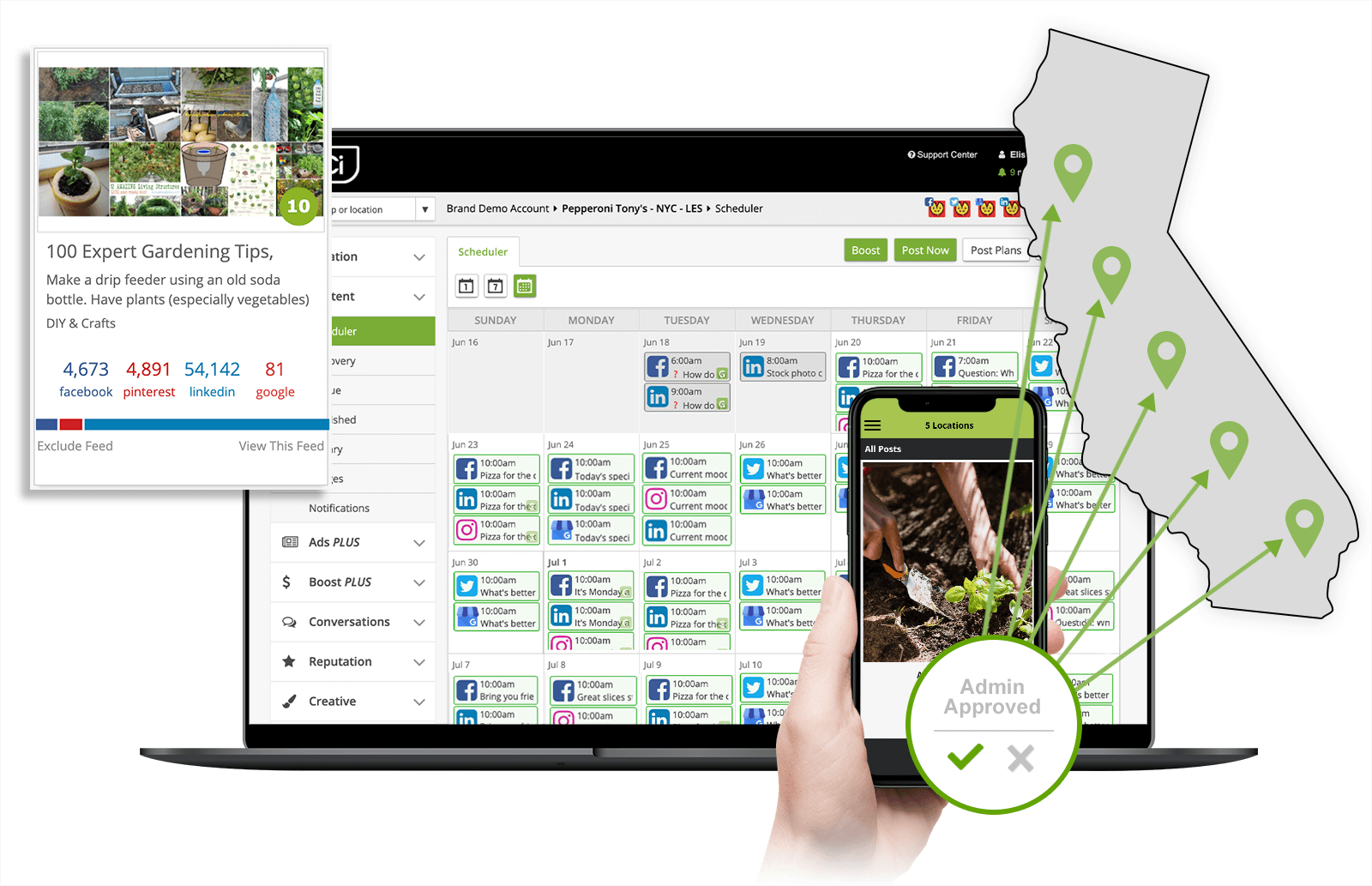Why Customer Experience Marketing is a Must + 6 Key Tactics
Customer experience, commonly referred to as CX, is the way customers perceive and feel about a company throughout the duration of their relationship with the business. Each interaction a customer has with a company shapes their perception of the brand.
In 2019, 60 percent of marketers were concerned that their current state of CX put them at a competitive disadvantage. To ensure that you’re not falling behind competitors when it comes to CX, consider incorporating customer experience marketing into your marketing plan.
In this blog, we’ll define what customer experience marketing is and its impact on your multi-location business and brand. We’ll also discuss six customer experience marketing strategies and share how to implement them.
A More In-Depth Look Into Customer Experience
Everything you do impacts customers’ perception of your business and their decision to come back or not. For instance, if a customer receives too much mail from a company, it can hurt their viewpoint of your business. On the other hand, a well-targeted product update or a positive interaction with a customer support specialist might increase brand loyalty.
Therefore, providing a stellar CX needs to be a central aspect of your business. By investing in CX, you’ll likely see an increase in repeat customers, customer loyalty, and customer advocacy. Part of a strong CX program is having an SEO and customer experience marketing strategy, which we’ll expand on in the next section.
What is Customer Experience Marketing?
A strong CX program works best when there’s buy-in from all major departments, including but not limited to marketing, sales, customer support, and product development. Let’s examine marketing a bit more closely.
CX marketing prioritizes the customer and your brand’s reputation ahead of lead generation and sales. Your marketing department puts the client’s needs at the center of its marketing strategy.
By putting the client’s needs first, a CX marketing strategy leads to an uptick in:
- Customer retention
- Customer lifetime value
- Product or service sales
- Brand advocates and word-of-mouth marketing
In the next section, we’ll discuss CX marketing strategies your marketing team and other major departments can implement to address customer pain points, reduce churn, and increase brand loyalty.
6 Customer Experience Marketing Strategies
These six CX marketing strategies aren’t difficult to implement. In fact, with the right tools and systems in place, you can execute them without having to expand your workforce.
1. Manage and Respond to Online Reviews
Reviews heavily impact both your online reputation and consumers’ purchasing decisions. Nearly 9 out of 10 consumers globally check online reviews before making a purchase. Both negative and positive reviews can heavily sway a consumer’s decision to purchase from your company. A CX marketing program can help reduce the number of negative reviews while simultaneously increasing positive reviews.
You’re likely wondering if there’s anything you can do to sway consumers’ decisions based on your business’s reviews. One of the most effective actions is proactively responding to online reviews.
According to one survey, consumers tend to read 10 reviews on average before deciding on a business. Of those who read reviews, 97 percent said they pay attention to the responses from the business.
Responding to both negative and positive reviews not only influences the reviewer’s opinion of your multi-location business, but these responses can also alter other consumers’ views. Here’s how multi-location businesses should respond to negative and positive reviews.
Responding to Negative Reviews:
Eighty-seven percent of consumers express a willingness to change a negative review depending on how the business responds. Part of CX marketing means helping customers. Your responses should reflect that attitude. Here are a few tips to keep in mind when responding to negative reviews:
- Never respond emotionally to a negative review
- Discuss recent updates you’ve made to fix the customer’s pain point
- Personalization is key
- Consider addressing the issue in a private conversation
- Give both a phone number and email address the reviewer can reach you at
Responding to Positive Reviews:
It’s essential to respond to positive feedback as well. By responding to positive reviews, you build trust with customers and create stronger ties. Below are a few actionable tips to keep in mind when responding to positive reviews:
- Thank the reviewer for their business
- Use the reviewer’s name in your response
- Personalize the review by mentioning the subject matter in the review
- Invite the customer back to your store or business
For more detailed information on how to respond to online reviews, download our Multi-Location Marketer’s Guide to Online Reputation Management.
To quickly respond to online reviews, you need to know when they’re happening. It can be challenging for multi-location businesses that receive dozens of reviews each week for individual locations across the country.
You need the right tool to manage these hundreds of reviews. SOCi’s streamlined reputation management software can help. With SOCi Reviews, your national and local marketing and customer service teams can monitor and quickly respond to every review left on primary review sites.
SOCi Reviews uses dynamic text capabilities to help you quickly write pre-crafted and personalized responses to positive and negative reviews.
2. Have Stellar Customer Service
Part of a strong CX program and CX marketing strategy means having stellar customer service. Disgruntled customers are much more likely to churn than satisfied ones.
Losing a customer means a loss of revenue and an increase in customer acquisition costs. Studies have revealed that acquiring a new customer can cost five to 25 times more than keeping an existing one.
Here are four ways to improve your customer service and better retain clients:
1. Simplify the Onboarding Process
A straightforward onboarding process will amaze your customers from the get-go. Moreover, they’ll be more likely to stick around, increasing your customer lifetime value.
The customer onboarding process gets new users or customers acquainted and comfortable with your organization or offerings. It often includes helpful guidance, or step-by-step tutorials and tours. For instance, if you’re a gym and fitness center, you’d want to give your new members a tour of the facilities and acquaint them with trainers and amenities.
2. Be Proactive with Your Customer Service
Traditionally, customer service is thought of as reactive. An issue arises and the customer contacts you. Proactive customer service means sharing product or service improvements with potential and existing customers. Proactive customer service reminds customers of your multi-location business’s growth and innovation and allows you to introduce new products without being pushy.
3. Have Multichannel Support
Multichannel support means being everywhere your customers are. Your multi-location business should have customer support options via a chatbot, phone, SMS, and email.
4. Utilize Omnichannel Support
Omnichannel support means providing consistent communications for your customers without sacrificing context. For example, suppose a customer uses a chatbot, and their issue needs escalation. In that case, they should stay within the chatbot, and the next customer service representative who contacts them should have a total understanding of the issue and what the previous agent already tried.
Now, you might be wondering how to measure the success of your customer service program. The best way to gain insights into how your customer service and CX programs are doing is to send surveys. The best surveys to send are Net Promoter Score (NPS), Customer Satisfaction (CSAT), and Customer Effort Score (CES) surveys. Read our article on customer advocacy KPIs (key performance indicators) for more information on these survey types.
Having a solid customer service department doesn’t mean you must hire more support agents. Multi-location businesses can use chatbot solutions like SOCi SmartBot to deliver 24/7 customer care. SOCi SmartBot can automate answers to frequently asked questions and will direct customers to the correct information. The chatbot also meets customers where they are, on Messenger from Meta, Google Business Profile accounts, or SMS text messaging.
3. Create Educational Content
Your CS marketing team can proactively satisfy customers by producing educational content. In today’s digital world, if people want to find more information about a topic or how to do something, they use search engines such as Google.
Your educational content should fall into three primary categories: Product specific, general educational, and local information.
Product Specific
Product-specific content is product tutorials or walk-throughs. These are created primarily by your customer service and product teams and are often a part of your onboarding process. These can also take the form of videos, downloadable PDFs, or online posts.
For instance, if you’re a property management company, you might create a universal PDF that explains how residents can pay rent via your online portal.
General Educational
General content means more top-of-funnel content that answers questions your customers or target audience might have about your industry or product. This content also takes the form of blog posts or videos. It’s an excellent way to create brand awareness, begin early customer acquisition, and helps with search engine optimization (SEO).
Local Information
For multi-location businesses, it’s essential to focus on local content as well. For each local landing page or online business listing, ensure that your NAP (name, address, and phone number) are up to date. Also, provide answers to local FAQs and monitor and respond to your Google Listing’s Q&A on the Google knowledge panel.
4. Interact and Respond on Social Media
It’s nearly impossible to discuss CX marketing, and marketing in general, without mentioning social media. Multi-location businesses can use social media in two main ways for CX marketing: to create content that interests your target audience and to respond to inquiries or complaints across various social platforms.
Creating Social Media Content
Remember, a CX marketing strategy keeps your customers’ needs at the forefront. Your social media content strategy shouldn’t differ. Nearly all of your social media content should benefit your clients by either informing them about product or service updates or sharing helpful information. Here’s a list of social media content users might be interested in:
- Helpful tips and strategies
- Example: A plant store sharing indoor gardening tips
- Thought leadership data or case studies
- Example: A property management company shares quarterly real estate market updates
- Product or service updates
- Example: A salon shares lowered prices for summer haircuts
- Interactive content or open-ended questions
- Example: A fitness center shares a survey to see how often members go to the gym
- Testimonials and reviews
- Example: A restaurant brand showcases online reviews from recent diners
- Partnerships or press releases
- Example: A local franchise owner is featured in a magazine
- Policies or beliefs
- Example: A local hardware store’s partnership with a nonprofit or supports a common cause
For more information on creating the best localized social content, download and read our Localized Social Content Guide.
Responding to Inquiries and Complaints
Both current and potential customers use social media to get in touch with a multi-location business. Consumers will often comment on social media posts or direct message a business on social media platforms with questions or concerns they might have. More than three-quarters of people who comment on social media expect companies to respond to them, and 83 percent of these commenters expect a reply within a day or less.
Because consumers often use social media to contact your company, social media, in some ways, is an extension of your customer service department. It’s up to you if your customer service team or marketing department is responsible for social media interactions.
Regardless of who is responsible, each social media inquiry must be responded to appropriately. You can use many of the same management and response tips from our online reviews section when crafting responses on social media.
If you’re finding it difficult to create social media content and manage responses across multiple platforms, consider using SOCi’s social media management tool. SOCi’s social media software allows you to create and deliver localized content across 100s or 1,000s of locations without sacrificing brand consistency. You can also easily manage and respond to engagement from social posts across all of your locations with pre-saved templated responses.
5. Address Customer Pain Points
One of the most critical aspects of CX is addressing customer pain points. While it often falls on product and customer service teams to fix these pain points, marketing teams should be aware of them.
Generally, product teams fix software bugs or product issues; while customer service representatives address customer pain points or inquiries in real-time. Part of your CX marketing strategy is to update customers when your teams have resolved significant pain points or issues.
Marketing and sales departments are often the ones who share when a new product or service update repairs a repeat pain point or issue. For example, sales teams might send an email, or marketing teams might create a social media post stating something like, “We’ve heard your issues with [pain point]. We’re now introducing [product or service update]. This update addresses the [pain point(s)] in the following ways [X, Y, and Z].”
The best way to determine and track customer pain points is to gather information and data from:
- Online reviews
- Feedback from sellers and customer service representatives
- Social listening
- Online surveys
Once enough qualitative and quantitative data is collected, you can begin to make minor modifications to your CX strategy.
6. Communicate Across Departments
A strong CX and CX marketing program depends on cross-departmental communication. Again, the central departments involved in CX are marketing, sales, customer service, and product development. Customer pain points and repeat issues or patterns must be shared across departments so three actions can occur.
First, the involved departments can address and fix the pain points. Second, each team can adequately address these concerns when interacting with customers and producing client-facing content. Finally, the marketing, sales, or customer service teams can strategically update clients once the product team resolves these issues.
In general, it’s better to over communicate than under-communicate across teams. To make cross-department communication regular, schedule bi-weekly or monthly calls between department heads.
When done well, CX marketing will increase your multi-location business’ brand loyalty and awareness. Your multi-location business will satisfy more clients, and many will become advocates on your behalf. Furthermore, a strong CX program lightens the load on your customer service department and creates more transparency within and across departments.
You’ll need the right tools to get the most out of your CX marketing efforts. SOCi’s Reviews, SmartBot, and social media management software can help. With these omnichannel tools, you’ll better manage and address customers’ inquiries and concerns across all of your business locations. For more information on how these products work, request a demo today!





